Impact of Soil Tillage Systems on CO2 Emissions, Soil Chemical Parameters, and Plant Growth Physiological Parameters (LAI, SPAD) in a Long-Term Tillage Experiment in Hungary
Abstract
1. Introduction
- To investigate the effects of conservation tillage and plant residue utilization on SOM and soil microbial respiration.
- To measure the canopy’s physiological responses and photosynthetic efficiency under different soil tillage practices.
- To evaluate the impact of crop rotations on soil, root, and yield in a conservation-managed agriculture system.
- Integrate root-shoot surrounding system performance metrics to identify agronomic practices ideal for crop production and conservation of long-term soil health.
2. Materials and Methods
2.1. Description of the Experimental Site
2.2. Weather Conditions and Precipitation Trends
2.3. Tillage Treatments
2.4. Soil Chemical Analyses
2.5. Crop Sequence
2.6. Soil CO2 Emissions
2.7. Leaf Area Index and Leaf Chlorophyll Content
2.8. Crop Yield
2.9. Grain Quality
2.10. Statistical Analysis
3. Results
3.1. Influence of Year Effect and Vegetation on Soil Carbon Dioxide (CO2) Emissions
3.2. Soil Carbon Dioxide (CO2) Emissions Under Different Soil Tillage Methods
3.3. Soil Chemical Properties Under Different Tillage Treatments
3.4. Leaf Area Index of Winter Barley–Soybean–Winter Wheat Crop Rotation Under Different Tillage Treatments
3.5. Leaf Chlorophyll Content of Winter Barley–Soybean–Winter Wheat Crop Rotation Under Different Soil Tillage Methods
3.6. Grain Yield Under Different Tillage Treatments
3.7. Grain Qualities Under Different Soil Tillage Methods
4. Discussion
4.1. Influence of Year Effect and Crops on Soil Carbon Dioxide (CO2) Emissions
4.2. Effect of Different Soil Tillage Methods on Soil Carbon Dioxide (CO2) Emissions
4.3. Effects of Soil Tillage on Soil Chemical Properties
4.4. Effects of Soil Tillage on Leaf Area Index of Winter Barley–Soybean–Winter Wheat Crop Rotation
4.5. Effects of Soil Tillage on Leaf Chlorophyll Content of Winter Barley–Soybean–Winter Wheat Crop Rotation
4.6. Effects of Tillage Treatments on Grain Yield
4.7. Effects of Tillage Treatments on Grain Quality
5. Conclusions
Author Contributions
Funding
Institutional Review Board Statement
Data Availability Statement
Acknowledgments
Conflicts of Interest
Abbreviations
| LAI | Leaf Area Index |
| SPAD | Soil Plant Analysis Development |
| PAR | Photosynthetically Active Radiation |
| NIR | Near-infrared spectroscopic equipment |
| ANOVA | Analysis of Variance |
| SOM | Soil Organic Matter |
| P | Ploughing |
| DC | Deep Cultivation |
| SC | Shallow Cultivation |
| L | Loosening |
| D | Disking |
| NT | No-till |
Appendix A
| Year | Culture | Management History | Seeding Rate | Doses | Date |
|---|---|---|---|---|---|
| 2021 | Winter barley | Fertilizing (NPK 8-21-21) | 300 kg ha−1 | 8 October | |
| Primary soil tillage | 12 October | ||||
| Seedbed preparation | 14 October | ||||
| Sowing | 200 kg ha−1 | 14 October | |||
| 2022 | Winter barley | Fertilizing (N 27) | 250 kg ha−1 | 2 April | |
| Plant protection | pethoxamid + terbuthylazine (3 L ha−1 formulation) | 20 April | |||
| nicosulfuron + dicamba + rimsulfuron (400 g ha−1 formulation) + ethoxy-isodecyl alcohol (0.1% ha−1) | 13 May | ||||
| Harvest | 19 June | ||||
| Weed control | glyphosate (4 L ha−1 formulation) | 26 August | |||
| Fertilizing (NPK 8-24-24) | 250 kg ha−1 | 5 October | |||
| Primary soil tillage for soybean | 5 October | ||||
| 2023 | Soybean | Weed control | glyphosate (4 L ha−1 formulation) | 31 March | |
| Fertilizing (N 27) | 200 kg ha−1 | 25 April | |||
| Seedbed preparation | 25 April | ||||
| Sowing | 100 kg ha−1 | 28 April | |||
| Weed control | nicosulfuron + dicamba + rimsulfuron (400 g ha−1 formulation) + ethoxy-isodecyl alcohol (0.1% ha−1) | 28 April | |||
| Plant protection | bentazone (2 L ha−1 formulation) | 5 June | |||
| Harvest | 28 September | ||||
| Fertilizing (NPK 8-21-21) | 300 kg ha−1 | 6 October | |||
| Primary soil tillage | 6 October | ||||
| Seedbed preparation | 11 October | ||||
| Sowing of winter wheat | 200 kg ha−1 | 11 October | |||
| 2024 | Winter wheat | Fertilizing (N 27) | 250 kg ha−1 | 10 April | |
| Plant protection | pethoxamid + terbuthylazine (3 L ha−1 formulation) | 26 April | |||
| Weed control | 5 L ha−1 nicosulfuron + dicamba + rimsulfuron (400 g ha−1 formulation) + ethoxy-isodecyl alcohol (0.1% ha−1) | 21 May | |||
| Harvest | 5 July |
References
- Rzaliyev, A.; Goloborodko, V.; Bekmuhametov, S.; Ospanbayev, Z.; Sembayeva, A. Influence of Tillage Methods on Food Security and Its Agrophysical and Water-Physical Properties. Food Sci. Technol. 2023, 43, e76221. [Google Scholar] [CrossRef]
- Lamichhane, J.R.; Boiffin, J.; Boizard, H.; Dürr, C.; Richard, G. Seedbed Structure of Major Field Crops as Affected by Cropping Systems and Climate: Results of a 15-Year Field Trial. Soil Tillage Res. 2021, 206, 104845. [Google Scholar] [CrossRef]
- Ben-Noah, I.; Fiedman, S.P. Review and Evaluation of Root Respiration andof atural and Agricultural Processes of Soil Aeriation. Vadose Zone J. 2018, 17, 1–47. [Google Scholar] [CrossRef]
- Nunes, M.R.; Karlen, D.L.; Moorman, T.B. Tillage Intensity Effects on Soil Structure Indicators—A US Meta-Analysis. Sustainability 2020, 12, 2071. [Google Scholar] [CrossRef]
- Schillaci, C.; Saia, S.; Lipani, A.; Perego, A.; Zaccone, C.; Acutis, M. Validating the Regional Estimates of Changes in Soil Organic Carbon by Using the Data from Paired-Sites: The Case Study of Mediterranean Arable Lands. Carbon Balance Manag. 2021, 16, 19. [Google Scholar] [CrossRef] [PubMed]
- Niewiadomska, A.; Majchrzak, L.; Borowiak, K.; Wolna-Maruwka, A.; Waraczewska, Z.; Budka, A.; Gaj, R. The Influence of Tillage and Cover Cropping on Soil Microbial Parameters and Spring Wheat Physiology. Agronomy 2020, 10, 200. [Google Scholar] [CrossRef]
- Liu, Z.; Cao, S.; Sun, Z.; Wang, H.; Qu, S.; Lei, N.; He, J.; Dong, Q. Tillage Effects on Soil Properties and Crop Yield after Land Reclamation. Sci. Rep. 2021, 11, 1–12. [Google Scholar] [CrossRef] [PubMed]
- Liu, X.; Li, R.; Lv, Y.; Zhang, X.; Zhang, Y.; Gao, Q.; Ma, Y.; Bizimana, F.; Liu, L.; Han, H.; et al. Two Pathways for Reducing Soil Aggregate Organic Carbon Mineralisation via Minimum Tillage under a Long-Term Field Experiment. J. Environ. Manag. 2025, 381, 125195. [Google Scholar] [CrossRef]
- da Silva Souza, C.B.; da Silva Farias, P.G.; Rosset, J.S.; Schiavo, J.A.; Ozório, J.M.B.; de Souza Oliveira, N.; da Silva Coêlho, R.; Tomazi, M.; Salton, J.C. Soil Quality and CO2 Emissions in Response to Six Years of Conventional and Integrated Agricultural Production in the Central-West Region of Brazil. J. Soil Sci. Plant Nutr. 2025, 25, 3954–3970. [Google Scholar] [CrossRef]
- Chang, F.; Yue, S.; Li, S.; Wang, H.; Chen, Y.; Yang, W.; Wu, B.; Sun, H.; Wang, S.; Yin, L.; et al. Periodic Straw-Derived Biochar Improves Crop Yield, Sequesters Carbon, and Mitigates Emissions. Eur. J. Agron. 2025, 164, 127516. [Google Scholar] [CrossRef]
- Weidhuner, A.; Hanauer, A.; Krausz, R.; Crittenden, S.J.; Gage, K.; Sadeghpour, A. Tillage Impacts on Soil Aggregation and Aggregate-Associated Carbon and Nitrogen after 49 Years. Soil Tillage Res. 2021, 208, 104878. [Google Scholar] [CrossRef]
- Steponavičienė, V.; Bogužas, V.; Sinkevičienė, A.; Skinulienė, L.; Vaisvalavičius, R.; Sinkevičius, A. Soil Water Capacity, Pore Size Distribution, and CO2 Emission in Different Soil Tillage Systems and Straw Retention. Plants 2022, 11, 614. [Google Scholar] [CrossRef]
- Huzsvai, L.; Zsembeli, J.; Kovács, E.; Juhász, C. Response of Winter Wheat (Triticum aestivum L.) Yield to the Increasing Weather Fluctuations in a Continental Region of Four-Season Climate. Agronomy 2022, 12, 314. [Google Scholar] [CrossRef]
- Wang, S.; Wang, H.; Hafeez, M.B.; Zhang, Q.; Yu, Q.; Wang, R.; Wang, X.; Li, J. No-Tillage and Subsoiling Increased Maize Yields and Soil Water Storage under Varied Rainfall Distribution: A 9-Year Site-Specific Study in a Semi-Arid Environment. Field Crops Res. 2020, 255, 107867. [Google Scholar] [CrossRef]
- Wittwer, R.A.; Klaus, V.H.; Oliveria, E.M.; Sun, Q.; Liu, Y.; Gilgen, A.; Buchmann, N.; van der Heijden, M.A. Limited capability of organic farming and conservation tillage to enhance agroecosystem resilience to severe drought. Agric. Syst. 2023, 211, 103721. [Google Scholar] [CrossRef]
- Peng, Q.; Liu, B.; Hu, Y.; Wang, A.; Guo, Q.; Yin, B.; Cao, Q.; He, L. The Role of Conventional Tillage in Agricultural Soil Erosion. Agric. Ecosyst. Environ. 2023, 348, 108407. [Google Scholar] [CrossRef]
- van Balen, D.; Cuperus, F.; Haagsma, W.; de Haan, J.; van den Berg, W.; Sukkel, W. Crop Yield Response to Long-Term Reduced Tillage in a Conventional and Organic Farming System on a Sandy Loam Soil. Soil Tillage Res. 2023, 225, 105553. [Google Scholar] [CrossRef]
- Su, Y.; Gabrielle, B.; Makowski, D. A Global Dataset for Crop Production under Conventional Tillage and No Tillage Systems. Sci. Data 2021, 8, 1–17. [Google Scholar] [CrossRef] [PubMed]
- Yao, X.; Chen, S.; Ding, S.; Zhang, M.; Cui, Z.; Linghu, S.; Xu, J. Temperature, Moisture, Hyperspectral Vegetation Indexes, and Leaf Traits Regulated Soil Respiration in Different Crop Planting Fields. J. Soil Sci. Plant Nutr. 2021, 21, 3203–3220. [Google Scholar] [CrossRef]
- Assefa Bogale, A.; Percze, A. The Influence of Primary Soil Tillage Methods and Foliar Nutrient Provision on the Growth, Yield, and Associated Traits of Winter Barley (Hordeum Vulgare L.). Acta Agrar. Debreceniensis 2025, 1, 19–26. [Google Scholar] [CrossRef] [PubMed]
- Abd Ghani, R.; Omar, S.; Jolánkai, M.; Tarnawa, Á.; Kende, Z.; Khalid, N.; Gyuricza, C.; Kassai, M.K. Soilless Culture Applications for Early Development of Soybean Crop (Glycine max L. Merr). Agriculture 2023, 13, 1713. [Google Scholar] [CrossRef]
- Liebhard, G.; Klik, A.; Neugschwandtner, R.W.; Nolz, R. Effects of Tillage Systems on Soil Water Distribution, Crop Development, and Evaporation and Transpiration Rates of Soybean. Agric. Water Manag. 2022, 269, 107719. [Google Scholar] [CrossRef]
- Documents|WRB. Available online: https://wrb.isric.org/documents/ (accessed on 18 July 2025).
- Farkas, C.; Birkás, M.; Várallyay, G. Soil Tillage Systems to Reduce the Harmful Effect of Extreme Weather and Hydrological Situations. Biologia 2009, 64, 624–628. [Google Scholar] [CrossRef]
- Weldmichael, T.G.; Szegi, T.; Denish, L.; Gangwar, R.K.; Michéli, E.; Simon, B. The Patterns of Soil Microbial Respiration and Earthworm Communities as Influenced by Soil and Land-Use Type in Selected Soils of Hungary. Soil Sci. Annu. 2020, 71, 139–148. [Google Scholar] [CrossRef]
- Bencsik, K.; Ujj, A.; Mikó, P. Evaluation of Different Soil Tillage Methods Regarding Sustainability and Soil Protection. Cereal Res. Commun. 2007, 35 Pt 1, 233–236. [Google Scholar] [CrossRef]
- Jakab, G.; Madarász, B.; Masoudi, M.; Karlik, M.; Király, C.; Zacháry, D.; Filep, T.; Dekemati, I.; Centeri, C.; Al-Graiti, T.; et al. Soil Organic Matter Gain by Reduced Tillage Intensity: Storage, Pools, and Chemical Composition. Soil Tillage Res. 2023, 226, 105584. [Google Scholar] [CrossRef]
- MSZ-08-0206/2-1978; pH-érték Potenciometria (KCl-os Szuszpenzió). Magyar Szabványügyi Testület: Budapest, Hungary, 1978.
- MSZ-08-0210:1977; Humusz Fotometria. Magyar Szabványügyi Testület: Budapest, Hungary, 1977.
- Kende, Z.; Sallai, A.; Kassai, K.; Mikó, P.; Percze, A.; Birkás, M. The Effects of Tillage-Induced Soil Disturbance on Weed Infestation of Winter Wheat. Pol. J. Environ. Stud. 2017, 26, 1131–1138. [Google Scholar] [CrossRef]
- Anda, A.; Simon-Gáspár, B.; Simon, S.; Soós, G.; Menyhárt, L. Modeling Risk in Fusarium Head Blight and Yield Analysis in Five Winter Wheat Production Regions of Hungary. Agriculture 2024, 14, 1093. [Google Scholar] [CrossRef]
- Kovács, G.P.; Simon, B.; Balla, I.; Bozóki, B.; Dekemati, I.; Gyuricza, C.; Percze, A.; Birkás, M. Conservation Tillage Improves Soil Quality and Crop Yield in Hungary. Agronomy 2023, 13, 894. [Google Scholar] [CrossRef]
- Palmero, F.; Fernandez, J.A.; Garcia, F.O.; Haro, R.J.; Prasad, P.V.V.; Salvagiotti, F.; Ciampitti, I.A. A Quantitative Review into the Contributions of Biological Nitrogen Fixation to Agricultural Systems by Grain Legumes. Eur. J. Agron. 2022, 136, 126514. [Google Scholar] [CrossRef]
- PP SYSTEMS EGM-5 OPERATION MANUALS Pdf Download|ManualsLib. Available online: https://www.manualslib.com/manual/1420959/Pp-Systems-Egm-5.html (accessed on 18 July 2025).
- DEVICES. AccuPAR LP-80. Available online: https://metergroup.com/products/accupar-lp-80/ (accessed on 17 June 2025).
- Chlorophyll Meter SPAD-502Plus for Agricultural Products|KONICA MINOLTA. Available online: https://sensing.konicaminolta.eu/mi-en/products/colour-measurement/chlorophyll-meter/spad-502plus (accessed on 18 July 2025).
- Gawęda, D.; Haliniarz, M. Grain Yield and Quality of Winter Wheat Depending on Previous Crop and Tillage System. Agriculture 2021, 11, 133. [Google Scholar] [CrossRef]
- MSZ ISO 5983-2:2009; Animal Feeding Stuffs—Determination of Nitrogen Content and Calculation og Crude Protein Content. Magyar Szabványügyi Testület: Budapest, Hungary, 2009.
- MSZ-6830-11:1999; Peroxidszám-Meghatározás. Magyar Szabványügyi Testület: Budapest, Hungary, 1999.
- Shapiro, S.S.; Wilk, M.B. An Analysis of Variance Test for Normality (Complete Samples). Biometrika 1965, 52, 591–611. [Google Scholar] [CrossRef]
- Breslow, N. A Generalized Kruskal-Wallis Test for Comparing K Samples Subject to Unequal Patterns of Censorship. Biometrika 1970, 57, 579. [Google Scholar] [CrossRef]
- Drebee, H.A.; Abdul Razak, N.A.; Brisam, A.A. What Are the Determinants of Investment in the Iraqi Agricultural Sector? IOP Conf. Ser. Earth Environ. Sci. 2021, 735, 012038. [Google Scholar] [CrossRef]
- Zhang, Y.; Hou, W.; Chi, M.; Sun, Y.; An, J.; Yu, N.; Zou, H. Simulating the effects of soil temperature and soil moisture on CO2 and CH4 emissions in rice-straw-enriched paddy soil. Catena 2020, 194, 104677. [Google Scholar] [CrossRef]
- Ruan, Y.; Kuzyakov, Y.; Liu, X.; Zhang, X.; Xu, Q.; Guo, J.; Guo, S.; Shen, Q.; Yang, Y.; Ling, N. Elevated temperature and CO2 strongly affect the growth strategies of soil bacteria. Nat. Commun. 2023, 14, 391. [Google Scholar] [CrossRef]
- Darenova, E.; Adamič, P.C.; Čater, M. Effect of temperature, water availability, and soil properties on soil CO2 efflux in beech-fir forests along the Carpathian Mts. Catena 2024, 240, 107974. [Google Scholar] [CrossRef]
- Ray, R.L.; Griffin, R.W.; Fares, A.; Elhassan, A.; Awal, R.; Woldesenbet, S.; Risch, E. Soil CO2 emission in response to organic amendments temperature, and rainfall. Sci. Rep. 2020, 10, 5849. [Google Scholar] [CrossRef] [PubMed]
- Sergeevna Kozun, Y.; Shagidullovich Kazeev, K.; Ilich Kolesnikov, S. Climatic Gradients of Biological Properties of Zonal Soils of Natural Lands. Geoderma 2022, 425, 116031. [Google Scholar] [CrossRef]
- Fernández-Martínez, M.; Sardans, J.; Chevallier, F.; Ciais, P.; Obersteiner, M.; Vicca, S.; Canadell, J.G.; Bastos, A.; Friedlingstein, P.; Sitch, S.; et al. Global Trends in Carbon Sinks and Their Relationships with CO2 and Temperature. Nat. Clim. Change 2019, 9, 73–79. [Google Scholar] [CrossRef]
- Wang, N.; Quesada, B.; Xia, L.; Butterbach-Bahl, K.; Goodale, C.L.; Kiese, R. Effects of Climate Warming on Carbon Fluxes in Grasslands—A Global Meta-Analysis. Glob. Change Biol. 2019, 25, 1839–1851. [Google Scholar] [CrossRef]
- Wang, J.; Quan, Q.; Chen, W.; Tian, D.; Ciais, P.; Crowther, T.W.; Mack, M.C.; Poulter, B.; Tian, H.; Luo, Y.; et al. Increased CO2 Emissions Surpass Reductions of Non-CO2 Emissions More under Higher Experimental Warming in an Alpine Meadow. Sci. Total Environ. 2021, 769, 144559. [Google Scholar] [CrossRef]
- Sushko, S.; Ananyeva, N.; Ivashchenko, K.; Vasenev, V.; Kudeyarov, V. Soil CO2 Emission, Microbial Biomass, and Microbial Respiration of Woody and Grassy Areas in Moscow (Russia). J. Soils Sediments 2019, 19, 3217–3225. [Google Scholar] [CrossRef]
- Sushko, S.V.; Ananyeva, N.D.; Ivashchenko, K.V.; Kudeyarov, V.N. Soil CO2 Emission, Microbial Biomass, and Basal Respiration of Chernozems under Different Land Uses. Eurasian Soil Sci. 2019, 52, 1091–1100. [Google Scholar] [CrossRef]
- Zhang, K.; Duan, M.; Xu, Q.; Wang, Z.; Liu, B.; Wang, L. Soil Microbial Functional Diversity and Root Growth Responses to Soil Amendments Contribute to CO2 Emission in Rainfed Cropland. Catena 2020, 195, 104747. [Google Scholar] [CrossRef]
- Piao, S.; Wang, X.; Wang, K.; Li, X.; Bastos, A.; Canadell, J.G.; Ciais, P.; Friedlingstein, P.; Sitch, S. Interannual Variation of Terrestrial Carbon Cycle: Issues and Perspectives. Glob. Change Biol. 2020, 26, 300–318. [Google Scholar] [CrossRef]
- Tao, F.; Li, Y.; Chen, Y.; Yin, L.; Zhang, S. Daily, Seasonal and Inter-Annual Variations in CO2 Fluxes and Carbon Budget in a Winter-Wheat and Summer-Maize Rotation System in the North China Plain. Agric. For. Meteorol. 2022, 324, 109098. [Google Scholar] [CrossRef]
- Ionita, M.; Nagavciuc, V. 2024: The Year with Too Much Summer in the Eastern Part of Europe. Weather 2025, 99. [Google Scholar] [CrossRef]
- Lennert, J.; Kovács, K.; Koós, B.; Swain, N.; Bálint, C.; Hamza, E.; Király, G.; Rácz, K.; Váradi, M.M.; Kovács, A.D. Climate Change, Pressures, and Adaptation Capacities of Farmers: Empirical Evidence from Hungary. Horticulturae 2024, 10, 56. [Google Scholar] [CrossRef]
- Szili-Kovács, T.; Takács, T. Advanced Research of Rhizosphere Microbial Activity. Agriculture 2023, 13, 911. [Google Scholar] [CrossRef]
- Yang, Y.; Zou, J.; Huang, W.; Olesen, J.E.; Li, W.; Rees, R.M.; Harrison, M.T.; Feng, B.; Feng, Y.; Chen, F.; et al. Drivers of Soybean-Based Rotations Synergistically Increase Crop Productivity and Reduce GHG Emissions. Agric. Ecosyst. Environ. 2024, 372, 109094. [Google Scholar] [CrossRef]
- Hao, Y.; Mao, J.; Bachmann, C.M.; Hoffman, F.M.; Koren, G.; Chen, H.; Tian, H.; Liu, J.; Tao, J.; Tang, J.; et al. Soil Moisture Controls over Carbon Sequestration and Greenhouse Gas Emissions: A Review. NPJ Clim. Atmos. Sci. 2025, 8, 1–14. [Google Scholar] [CrossRef]
- Juhász, C.; Huzsvai, L.; Kovács, E.; Kovács, G.; Tuba, G.; Sinka, L.; Zsembeli, J. Carbon Dioxide Efflux of Bare Soil as a Function of Soil Temperature and Moisture Content under Weather Conditions of Warm, Temperate, Dry Climate Zone. Agronomy 2022, 12, 3050. [Google Scholar] [CrossRef]
- Das, A.; Brown, L.; McFarlane, A. Asymmetric Effects of Financial Development on CO2 Emissions in Bangladesh. J. Risk Financ. Manag. 2023, 16, 269. [Google Scholar] [CrossRef]
- Steponavičienė, V.; Žiūraitis, G.; Rudinskienė, A.; Jackevičienė, K.; Bogužas, V. Long-Term Effects of Different Tillage Systems and Their Impact on Soil Properties and Crop Yields. Agronomy 2024, 14, 870. [Google Scholar] [CrossRef]
- Mühlbachová, G.; Růžek, P.; Kusá, H.; Vavera, R. CO2 Emissions from Soils under Different Tillage Practices and Weather Conditions. Agronomy 2023, 13, 3084. [Google Scholar] [CrossRef]
- Sawinska, Z.; Radzikowska-Kujawska, D.; Blecharczyk, A.; Świtek, S.; Piechota, T.; Cieślak, A.; Cardenas, L.M.; Louro-Lopez, A.; Gregory, A.S.; Coleman, K.; et al. How Tillage System Affects the Soil Carbon Dioxide Emission and Wheat Plants Physiological State. Agronomy 2024, 14, 2220. [Google Scholar] [CrossRef]
- Cui, H.; Wang, Y.; Luo, Y.; Jin, M.; Chen, J.; Pang, D.; Li, Y.; Wang, Z. Tillage Strategies Optimize SOC Distribution to Reduce Carbon Footprint. Soil Tillage Res. 2022, 223, 105499. [Google Scholar] [CrossRef]
- Franco-Luesma, S.; Cavero, J.; Plaza-Bonilla, D.; Cantero-Martínez, C.; Arrúe, J.L.; Álvaro-Fuentes, J. Tillage and Irrigation System Effects on Soil Carbon Dioxide (CO2) and Methane (CH4) Emissions in a Maize Monoculture under Mediterranean Conditions. Soil Tillage Res. 2020, 196, 104488. [Google Scholar] [CrossRef]
- Gao, L.; Wang, B.; Li, S.; Han, Y.; Zhang, X.; Gond, D.; Ma, M.; Liang, G.; Wu, H.; Wu, X.; et al. Effects of different long-term tillage systems on the composition of organic matter by 13C CP/TOSS NMR in physical fractions in the Loess Plateau of China. Soil Tillage Res. 2019, 194, 104321. [Google Scholar] [CrossRef]
- Mohammed, S.; Mirzaei, M.; Pappné Törő, Á.; Anari, M.G.; Moghiseh, E.; Asadi, H.; Szabó, S.; Kakuszi-Széles, A.; Harsányi, E. Soil Carbon Dioxide Emissions from Maize (Zea mays L.) Fields as Influenced by Tillage Management and Climate*. Irrig. Drain. 2022, 71, 228–240. [Google Scholar] [CrossRef]
- Ruis, S.J.; Blanco-Canqui, H.; Jasa, P.J.; Jin, V.L. No-till Farming and Greenhouse Gas Fluxes: Insights from Literature and Experimental Data. Soil Tillage Res. 2022, 220, 105359. [Google Scholar] [CrossRef]
- Ogle, S.M.; Alsaker, C.; Baldock, J.; Bernoux, M.; Breidt, F.J.; McConkey, B.; Regina, K.; Vazquez-Amabile, G.G. Climate and Soil Characteristics Determine Where No-Till Management Can Store Carbon in Soils and Mitigate Greenhouse Gas Emissions. Sci. Rep. 2019, 9, 1–8. [Google Scholar] [CrossRef]
- Jaskulski, D.; Jaskulska, I.; Różniak, E.; Radziemska, M.; Brtnický, M. Cultivation of Crops in Strip-Till Technology and Microgranulated Fertilisers Containing a Gelling Agent as a Farming Response to Climate Change. Agriculture 2023, 13, 1981. [Google Scholar] [CrossRef]
- Buragienė, S.; Šarauskis, E.; Romaneckas, K.; Adamavičienė, A.; Kriaučiūnienė, Z.; Avižienytė, D.; Marozas, V.; Naujokienė, V. Relationship between CO2 Emissions and Soil Properties of Differently Tilled Soils. Sci. Total Environ. 2019, 662, 786–795. [Google Scholar] [CrossRef]
- Li, Z.; Zhang, Q.; Li, Z.; Qiao, Y.; Du, K.; Yue, Z.; Tian, C.; Leng, P.; Cheng, H.; Chen, G.; et al. Responses of Soil Greenhouse Gas Emissions to No-Tillage: A Global Meta-Analysis. Sustain. Prod. Consum. 2023, 36, 479–492. [Google Scholar] [CrossRef]
- Pareja-Sánchez, E.; Cantero-Martínez, C.; Álvaro-Fuentes, J.; Plaza-Bonilla, D. Tillage and Nitrogen Fertilization in Irrigated Maize: Key Practices to Reduce Soil CO2 and CH4 Emissions. Soil Tillage Res. 2019, 191, 29–36. [Google Scholar] [CrossRef]
- Shakoor, A.; Shahbaz, M.; Farooq, T.H.; Sahar, N.E.; Shahzad, S.M.; Altaf, M.M.; Ashraf, M. A Global Meta-Analysis of Greenhouse Gases Emission and Crop Yield under No-Tillage as Compared to Conventional Tillage. Sci. Total Environ. 2021, 750, 142299. [Google Scholar] [CrossRef]
- Bregaglio, S.; Mongiano, G.; Ferrara, R.M.; Ginaldi, F.; Lagomarsino, A.; Rana, G. Which Are the Most Favourable Conditions for Reducing Soil CO2 Emissions with No-Tillage? Results from a Meta-Analysis. Int. Soil Water Conserv. Res. 2022, 10, 497–506. [Google Scholar] [CrossRef]
- Dencső, M.; Horel, Á.; Bakacsi, Z.; Birkás, M.; Takács, T.; Füzy, A.; Szili-Kovács, T.; Balla, I.; Tóth, E. Is Soil Respiration of a Chernozem under Shallow Cultivation Similar to Moldboard Plowing or No-Tillage? Soil Tillage Res. 2025, 253, 106644. [Google Scholar] [CrossRef]
- Kulmány, I.M.; Giczi, Z.; Beslin, A.; Bede, L.; Kalocsai, R.; Vona, V. Impact of Environmental and Soil Factors in the Prediction of Soil Carbon Dioxide Emissions under Different Tillage Systems. Ecocycles 2022, 8, 27–39. [Google Scholar] [CrossRef]
- Balla Kovács, A.; Juhász, E.K.; Béni, Á.; Kincses, I.; Tállai, M.; Sándor, Z.; Kátai, J.; Rátonyi, T.; Kremper, R. Changes in Microbial Community and Activity of Chernozem Soil under Different Management Systems in a Long-Term Field Experiment in Hungary. Agronomy 2024, 14, 745. [Google Scholar] [CrossRef]
- Firth, A.G.; Brooks, J.P.; Locke, M.A.; Morin, D.J.; Brown, A.; Baker, B.H. Dynamics of Soil Organic Carbon and CO2; Flux under Cover Crop and No-Till Management in Soybean Cropping Systems of the Mid-South (USA). Environments 2022, 9, 109. [Google Scholar] [CrossRef]
- Silva, B.d.O.; Moitinho, M.R.; Santos, G.A.d.A.; Teixeira, D.D.B.; Fernandes, C.; La Scala, N. Soil CO2 Emission and Short-Term Soil Pore Class Distribution after Tillage Operations. Soil Tillage Res. 2019, 186, 224–232. [Google Scholar] [CrossRef]
- Wolff, M.W.; Alsina, M.M.; Stockert, C.M.; Khalsa, S.D.S.; Smart, D.R. Minimum Tillage of a Cover Crop Lowers Net GWP and Sequesters Soil Carbon in a California Vineyard. Soil Tillage Res. 2018, 175, 244–254. [Google Scholar] [CrossRef]
- Man, M.; Wagner-Riddle, C.; Dunfield, K.E.; Deen, B.; Simpson, M.J. Long-term Crop Rotation and Different Tillage Practices Alter Soil Organic Matter Composition and Degradation. Soil Tillage Res. 2021, 209, 104960. [Google Scholar] [CrossRef]
- Gao, Q.; Ma, L.; Fang, Y.; Zhang, A.; Li, G.; Wang, J.; Wu, D.; Wu, W.; Du, Z. Conservation Tillage for 17years Alters the Molecular Composition of Organic Matter in Soil Profile. Sci. Total Environ. 2021, 762, 143116. [Google Scholar] [CrossRef] [PubMed]
- Lv, L.; Gao, Z.; Liao, K.; Zhu, Q.; Zhu, J. Impact of Conservation Tillage on the Distribution of Soil Nutrients with Depth. Soil Tillage Res. 2023, 225, 105527. [Google Scholar] [CrossRef]
- Vincent-Caboud, L.; Casagrande, M.; David, C.; Ryan, M.R.; Silva, E.M.; Peigne, J. Using Mulch from Cover Crops to Facilitate Organic No-till Soybean and Maize Production. A Review. Agron. Sustain. Dev. 2019, 39, 1–15. [Google Scholar] [CrossRef]
- Li, Y.; Chen, H.; Feng, H.; Dong, Q.; Wu, W.; Zou, Y.; Chau, H.W.; Siddique, K.H.M. Influence of Straw Incorporation on Soil Water Utilization and Summer Maize Productivity: A Five-Year Field Study on the Loess Plateau of China. Agric. Water Manag. 2020, 233, 106106. [Google Scholar] [CrossRef]
- Liu, S.; Gao, Y.; Lang, H.; Liu, Y.; Zhang, H. Effects of Conventional Tillage and No-Tillage Systems on Maize (Zea mays L.) Growth and Yield, Soil Structure, and Water in Loess Plateau of China: Field Experiment and Modeling Studies. Land 2022, 11, 1881. [Google Scholar] [CrossRef]
- Ali, A.M.; Savin, I.; Poddubskiy, A.; Abouelghar, M.; Saleh, N.; Abutaleb, K.; El-Shirbeny, M.; Dokukin, P. Integrated Method for Rice Cultivation Monitoring Using Sentinel-2 Data and Leaf Area Index. Egypt. J. Remote Sens. Space Sci. 2021, 24, 431–441. [Google Scholar] [CrossRef]
- Różewicz, M.; Grabiński, J.; Wyzińska, M. Effect of Strip-till and Cultivar on Photosynthetic Parameters and Grain Yield of Winter Wheat. Int. Agrophys 2024, 38, 279–291. [Google Scholar] [CrossRef]
- Cañete-Salinas, P.; Zamudio, F.; Yáñez, M.; Gajardo, J.; Valdés, H.; Espinosa, C.; Venegas, J.; Retamal, L.; Ortega-Farias, S.; Acevedo-Opazo, C. Evaluation of Models to Determine LAI on Poplar Stands Using Spectral Indices from Sentinel-2 Satellite Images. Ecol. Model. 2020, 428, 109058. [Google Scholar] [CrossRef]
- Irmak, S.; Kukal, M.S.; Mohammed, A.T.; Djaman, K. Disk-till vs. No-till Maize Evapotranspiration, Microclimate, Grain Yield, Production Functions and Water Productivity. Agric. Water Manag. 2019, 216, 177–195. [Google Scholar] [CrossRef]
- Geris, J.; Verrot, L.; Gao, L.; Peng, X.; Oyesiku-Blakemore, J.; Smith, J.U.; Hodson, M.E.; McKenzie, B.M.; Zhang, G.; Hallett, P.D. Importance of Short-Term Temporal Variability in Soil Physical Properties for Soil Water Modelling under Different Tillage Practices. Soil Tillage Res. 2021, 213, 105132. [Google Scholar] [CrossRef]
- Hu, R.; Liu, Y.; Chen, T.; Zheng, Z.; Peng, G.; Zou, Y.; Tang, C.; Shan, X.; Zhou, Q.; Li, J. Responses of Soil Aggregates, Organic Carbon, and Crop Yield to Short-Term Intermittent Deep Tillage in Southern China. J. Clean. Prod. 2021, 298, 126767. [Google Scholar] [CrossRef]
- Yang, Y.; Wu, J.; Du, Y.L.; Gao, C.; Pan, X.; Tang, D.W.S.; van der Ploeg, M. Short- and Long-Term Straw Mulching and Subsoiling Affect Soil Water, Photosynthesis, and Water Use of Wheat and Maize. Front. Agron. 2021, 3, 708075. [Google Scholar] [CrossRef]
- Dang, Y.P.; Balzer, A.; Crawford, M.; Rincon-Florez, V.; Liu, H.; Melland, A.R.; Antille, D.; Kodur, S.; Bell, M.J.; Whish, J.P.M.; et al. Strategic Tillage in Conservation Agricultural Systems of North-Eastern Australia: Why, Where, When and How? Environ. Sci. Pollut. Res. 2018, 25, 1000–1015. [Google Scholar] [CrossRef]
- Li, Z.; Lai, X.; Yang, Q.; Yang, X.; Cui, S.; Shen, Y. In Search of Long-Term Sustainable Tillage and Straw Mulching Practices for a Maize-Winter Wheat-Soybean Rotation System in the Loess Plateau of China. Field Crops Res. 2018, 217, 199–210. [Google Scholar] [CrossRef]
- Liu, X.; Dong, W.; Jia, S.; Liu, Q.; Li, Y.; Hossain, M.E.; Liu, E.; Kuzyakov, Y. Transformations of N Derived from Straw under Long-Term Conventional and No-Tillage Soils: A 15N Labelling Study. Sci. Total Environ. 2021, 786, 147428. [Google Scholar] [CrossRef]
- Cai, A.; Han, T.; Ren, T.; Sanderman, J.; Rui, Y.; Wang, B.; Smith, P.; Xu, M.; Li, Y. Declines in Soil Carbon Storage under No Tillage Can Be Alleviated in the Long Run. Geoderma 2022, 425, 116028. [Google Scholar] [CrossRef]
- Nouri, A.; Lee, J.; Yin, X.; Tyler, D.D.; Saxton, A.M. Thirty-Four Years of No-Tillage and Cover Crops Improve Soil Quality and Increase Cotton Yield in Alfisols, Southeastern USA. Geoderma 2019, 337, 998–1008. [Google Scholar] [CrossRef]
- Nunes, M.R.; van Es, H.M.; Schindelbeck, R.; Ristow, A.J.; Ryan, M. No-till and Cropping System Diversification Improve Soil Health and Crop Yield. Geoderma 2018, 328, 30–43. [Google Scholar] [CrossRef]
- Yang, H.; Wu, G.; Mo, P.; Chen, S.; Wang, S.; Xiao, Y.; Ma, H.A.; Wen, T.; Guo, X.; Fan, G. The Combined Effects of Maize Straw Mulch and No-Tillage on Grain Yield and Water and Nitrogen Use Efficiency of Dry-Land Winter Wheat (Triticum aestivum L.). Soil Tillage Res. 2020, 197, 104485. [Google Scholar] [CrossRef]
- Dekemati, I.; Simon, B.; Bogunovic, I.; Kisic, I.; Kassai, K.; Kende, Z.; Birkás, M. Long Term Effects of Ploughing and Conservation Tillage Methods on Earthworm Abundance and Crumb Ratio. Agronomy 2020, 10, 1552. [Google Scholar] [CrossRef]
- Janusauskaite, D.; Kadziene, G. Influence of Different Intensities of Tillage on Physiological Characteristics and Productivity of Crop-Rotation Plants. Plants 2022, 11, 3107. [Google Scholar] [CrossRef]
- Hirooka, Y.; Shoji, K.; Watanabe, Y.; Izumi, Y.; Awala, S.K.; Iijima, M. Ridge Formation with Strip Tillage Alleviates Excess Moisture Stress for Drought-Tolerant Crops. Soil Tillage Res. 2019, 195, 104429. [Google Scholar] [CrossRef]
- Binder, A.; Jócsák, I.; Varga, Z.; Knolmajer, B.; Keszthelyi, S. Non-Invasive Evaluation of Different Soil Tillage and Seed Treatment Effects on the Microbial Originating Physiological Reactions of Developing Juvenile Maize. Plants 2022, 11, 2506. [Google Scholar] [CrossRef]
- Li, Q.; Wang, M.; Fu, Q.; Li, T.; Liu, D.; Hou, R.; Li, H.; Cui, S.; Ji, Y. Short-Term Influence of Biochar on Soil Temperature, Liquid Moisture Content and Soybean Growth in a Seasonal Frozen Soil Area. J. Environ. Manag. 2020, 266, 110609. [Google Scholar] [CrossRef]
- Yin, Q.; Zhang, Y.; Li, W.; Wang, J.; Wang, W.; Ahmad, I.; Zhou, G.; Huo, Z. Better Inversion of Wheat Canopy SPAD Values before Heading Stage Using Spectral and Texture Indices Based on UAV Multispectral Imagery. Remote Sens. 2023, 15, 4935. [Google Scholar] [CrossRef]
- Szulc, P.; Bocianowski, J.; Nowosad, K.; Zielewicz, W.; Kobus-cisowska, J. Spad Leaf Greenness Index: Green Mass Yield Indicator of Maize (Zea mays L.), Genetic and Agriculture Practice Relationship. Plants 2021, 10, 830. [Google Scholar] [CrossRef]
- Farhangi-Abriz, S.; Ghassemi-Golezani, K.; Torabian, S. A Short-Term Study of Soil Microbial Activities and Soybean Productivity under Tillage Systems with Low Soil Organic Matter. Appl. Soil Ecol. 2021, 168, 104122. [Google Scholar] [CrossRef]
- Yadav, K.; Singh, R.; Kumar, J.; Nayak, P.; Gaurav, K.; Mangaraj, A.; Shukla, D.K.; Naresh, R. Effect of Different Tillage and Nutrient Management Practices on Initial Population and SPAD Value in Wheat (Triticum aestivum L.). Pharm. Innov. J. 2022, 11, 408–412. [Google Scholar]
- Yang, H.; Yang, J.P.; Li, F.H.; Liu, N. Replacing the Nitrogen Nutrition Index by SPAD Values and Analysis of Effect Factors for Estimating Rice Nitrogen Status. Agron. J. 2018, 110, 545–554. [Google Scholar] [CrossRef]
- Yue, X.; Hu, Y.; Zhang, H.; Schmidhalter, U. Evaluation of Both SPAD Reading and SPAD Index on Estimating the Plant Nitrogen Status of Winter Wheat. Int. J. Plant Prod. 2020, 14, 67–75. [Google Scholar] [CrossRef]
- Gabriel, J.L.; Quemada, M.; Alonso-Ayuso, M.; Lizaso, J.I.; Martín-Lammerding, D. Predicting N Status in Maize with Clip Sensors: Choosing Sensor, Leaf Sampling Point, and Timing. Sensors 2019, 19, 3881. [Google Scholar] [CrossRef] [PubMed]
- Piao, L.; Li, M.; Xiao, J.; Gu, W.; Zhan, M.; Cao, C.; Zhao, M.; Li, C. Effects of Soil Tillage and Canopy Optimization on Grain Yield, Root Growth, and Water Use Efficiency of Rainfed Maize in Northeast China. Agronomy 2019, 9, 336. [Google Scholar] [CrossRef]
- de Cárcer, P.S.; Sinaj, S.; Santonja, M.; Fossati, D.; Jeangros, B. Long-Term Effects of Crop Succession, Soil Tillage and Climate on Wheat Yield and Soil Properties. Soil Tillage Res. 2019, 190, 209–219. [Google Scholar] [CrossRef]
- Scapino, M.; Meloni, R.; Blandino, M. A Comparison of the Agronomic Management of a Winter Barley Hybrid and a Conventional Genotype: Effect of the Seeding Rate, Soil Tillage and Nitrogen Fertilization. Front. Agron. 2025, 7, 1546989. [Google Scholar] [CrossRef]
- Wang, H.; Wang, S.; Yu, Q.; Zhang, Y.; Wang, R.; Li, J.; Wang, X. No Tillage Increases Soil Organic Carbon Storage and Decreases Carbon Dioxide Emission in the Crop Residue-Returned Farming System. J. Environ. Manag. 2020, 261, 110261. [Google Scholar] [CrossRef]
- Blanco-Canqui, H.; Hassim, R.; Shapiro, C.; Jasa, P.; Klopp, H. How Does No-till Affect Soil-Profile Compactibility in the Long Term? Geoderma 2022, 425, 116016. [Google Scholar] [CrossRef]
- Jensen, J.L.; Thomsen, I.K.; Eriksen, J.; Christensen, B.T. Spring Barley Grown for Decades with Straw Incorporation and Cover Crops: Effects on Crop Yields and N Uptake. Field Crops Res. 2021, 270, 108228. [Google Scholar] [CrossRef]
- Orzech, K.; Wanic, M.; Załuski, D. The Effects of Soil Compaction and Different Tillage Systems on the Bulk Density and Moisture Content of Soil and the Yields of Winter Oilseed Rape and Cereals. Agriculture 2021, 11, 666. [Google Scholar] [CrossRef]
- Woźniak, A. Effect of Various Systems of Tillage on Winter Barley Yield, Weed Infestation and Soil Properties. Appl. Ecol. Environ. Res. 2020, 18, 3483–3496. [Google Scholar] [CrossRef]
- Shahadha, S.S.; Wendroth, O. Modeling the Effect of Tillage and Irrigation Management on Water and Barley Productivity for Different Soil Textures. Soil Tillage Res. 2025, 250, 106505. [Google Scholar] [CrossRef]
- Shi, X.; Li, C.; Li, P.; Zong, Y.; Zhang, D.; Gao, Z.; Hao, X.; Wang, J.; Lam, S.K. Deep Plowing Increases Soil Water Storage and Wheat Yield in a Semiarid Region of Loess Plateau in China: A Simulation Study. Field Crops Res. 2024, 308, 109299. [Google Scholar] [CrossRef]
- Buczek, J.; Migut, D.; Jańczak-Pieniażek, M. Effect of Soil Tillage Practice on Photosynthesis, Grain Yield and Quality of Hybrid Winter Wheat. Agriculture 2021, 11, 479. [Google Scholar] [CrossRef]
- Aixia, R.; Weifeng, Z.; Anwar, S.; Wen, L.; Pengcheng, D.; Ruixuan, H.; Peiru, W.; Rong, Z.; Jin, T.; Zhiqiang, G.; et al. Effects of Tillage and Seasonal Variation of Rainfall on Soil Water Content and Root Growth Distribution of Winter Wheat under Rainfed Conditions of the Loess Plateau, China. Agric. Water Manag. 2022, 268, 107533. [Google Scholar] [CrossRef]
- Nankova, M.; Bankova-Atanasova, G. Effect of the Main Soil Tillage Types on the Agronomic Response of Wheat in the Region of Souht Dobrudzha. Agric. Conspec. Sci. 2018, 83, 63–69. [Google Scholar]
- Abdollahi, L.; Getahun, G.T.; Munkholm, L.J. Eleven Years’ Effect of Conservation Practices for Temperate Sandy Loams: I. Soil Physical Properties and Topsoil Carbon Content. Soil Sci. Soc. Am. J. 2017, 81, 380–391. [Google Scholar] [CrossRef]
- Lin, T.S.; Song, Y.; Lawrence, P.; Kheshgi, H.S.; Jain, A.K. Worldwide Maize and Soybean Yield Response to Environmental and Management Factors Over the 20th and 21st Centuries. J. Geophys. Res. 2021, 126, e2021JG006304. [Google Scholar] [CrossRef]
- Adamič, S.; Leskovšek, R. Soybean (Glycine max (L.) Merr.) Growth, Yield, and Nodulation in the Early Transition Period from Conventional Tillage to Conservation and No-Tillage Systems. Agronomy 2021, 11, 2477. [Google Scholar] [CrossRef]
- Faligowska, A.; Panasiewicz, K.; Szymańska, G.; Ratajczak, K. Optimizing Soybean Productivity: A Comparative Analysis of Tillage and Sowing Methods and Their Effects on Yield and Quality. Agriculture 2025, 15, 626. [Google Scholar] [CrossRef]
- Bryant, C.J.; Krutz, L.J.; Reynolds, D.B.; Locke, M.A.; Golden, B.R.; Irby, T.; Steinriede, R.W.; Spencer, G.D.; Mills, B.E.; Wood, C.W. Conservation Soybean Production Systems in the Mid-Southern USA: I. Transitioning from Conventional to Conservation Tillage. Crop Forage Turfgrass Manag. 2020, 6, e20055. [Google Scholar] [CrossRef]
- Amato, G.; Ruisi, P.; Frenda, A.S.; di Miceli, G.; Saia, S.; Plaia, A.; Giambalvo, D. Long-Term Tillage and Crop Sequence Effects on Wheat Grain Yield and Quality. Agron. J. 2013, 105, 1317–1327. [Google Scholar] [CrossRef]
- Pearsons, K.A.; Omondi, E.C.; Heins, B.J.; Zinati, G.; Smith, A.; Rui, Y. Reducing Tillage Affects Long-Term Yields but Not Grain Quality of Maize, Soybeans, Oats and Wheat Produced in Three Contrasting Farming Systems. Sustainability 2022, 14, 631. [Google Scholar] [CrossRef]
- Chet, F.; Chet, C.; Bogdan, I.; Pop, A.I.; Moraru, P.I.; Rusu, T. The Effects of Management (Tillage, Fertilization, Plant Density) on Soybean Yield and Quality in a Three-Year Experiment under Transylvanian Plain Climate Conditions. Land 2021, 10, 200. [Google Scholar] [CrossRef]
- Urdă, C.; Suciu, L.; Mureşanu, F.; Păcurar, L.; Tritean, N.; Negrea, A.; Crișan, I.; Rezi, R.; Russu, F.; Tărău, A. Influence of Soil Tillage System, Fertilizer and Treatment Applied to Seeds on Soybean Chemical Composition. Rom. J. Plant Prot. 2021, 14, 17–23. [Google Scholar] [CrossRef]
- Jug, I.; Jug, D.; Sabo, M.; Stipešević, B.; Stošić, M. Winter Wheat Yield and Yield Components as Affected by Soil Tillage Systems. Turk. J. Agric. For. 2011, 35, 1–7. [Google Scholar] [CrossRef]
- Morris, C.F.; Li, S.; King, G.E.; Engle, D.A.; Burns, J.W.; Ross, A.S. A Comprehensive Genotype and Environment Assessment of Wheat Grain Ash Content in Oregon and Washington: Analysis of Variation. Cereal Chem. 2009, 86, 307–312. [Google Scholar] [CrossRef]
- Panasiewicz, K.; Faligowska, A.; Szymanska, G.; Szukała, J.; Ratajczak, K.; Sulewska, H. The Effect of Various Tillage Systems on Productivity of Narrow-Leaved Lupin-Winter Wheat-Winter Triticale-Winter Barley Rotation. Agronomy 2020, 10, 304. [Google Scholar] [CrossRef]
- Xu, L.; Tang, G.; Wu, D.; Han, Y.; Zhang, J. Effects of Tillage and Maturity Stage on the Yield, Nutritive Composition, and Silage Fermentation Quality of Whole-Crop Wheat. Front. Plant Sci. 2024, 15, 1357442. [Google Scholar] [CrossRef]
- Šíp, V.; Vavera, R.; Chrpová, J.; Kusá, H.; Růžek, P. Winter Wheat Yield and Quality Related to Tillage Practice, Input Level and Environmental Conditions. Soil Tillage Res. 2013, 132, 77–85. [Google Scholar] [CrossRef]
- Woźniak, A.; Haliniarz, M. Response of Winter Wheat to 35-Year Cereal Monoculture. Agriculture 2025, 15, 489. [Google Scholar] [CrossRef]
- Kerbouai, I.; Sfayhi, D.; Sassi, K.; M’hamed, H.C.; Jenfaoui, H.; Riahi, J.; Arfaoui, S.; Chouaibi, M.; Ben Ismail, H. Influence of Conservation Agriculture on Durum Wheat Grain, Dough Texture Profile and Pasta Quality in a Mediterranean Region. Agriculture 2023, 13, 908. [Google Scholar] [CrossRef]
- Peigné, J.; Messmer, M.; Aveline, A.; Berner, A.; Mäder, P.; Carcea, M.; Narducci, V.; Samson, M.F.; Thomsen, I.K.; Celette, F.; et al. Wheat Yield and Quality as Influenced by Reduced Tillage in Organic Farming. Org. Agric. 2014, 4, 1–13. [Google Scholar] [CrossRef]
- Buczek, J. Quality and Productivity of Hybrid Wheat Depending on the Tillage Practices. Plant Soil Environ. 2020, 66, 415–420. [Google Scholar] [CrossRef]
- Yilmaz, H.; Karatas, R.; Demirel, F.; Soysal, S.; Türkoğlu, A.; Yilmaz, A.; Ciftci, V. Variations in Protein, Gluten, Zeleny Sedimentation and Yield of Certain Wheat (Triticum aestivum L.) Cultivars under Different Climatic Conditions. Euphytica 2024, 220, 1–11. [Google Scholar] [CrossRef]
- Eliş, S.; Yıldırım, M. Changes in Quality Components of Durum Wheat Genotypes Under Temperature Stress and Sufficient Rainfall Conditions During the Growth Period. Proc. Bulg. Acad. Sci. 2024, 77, 1888–1898. [Google Scholar] [CrossRef]
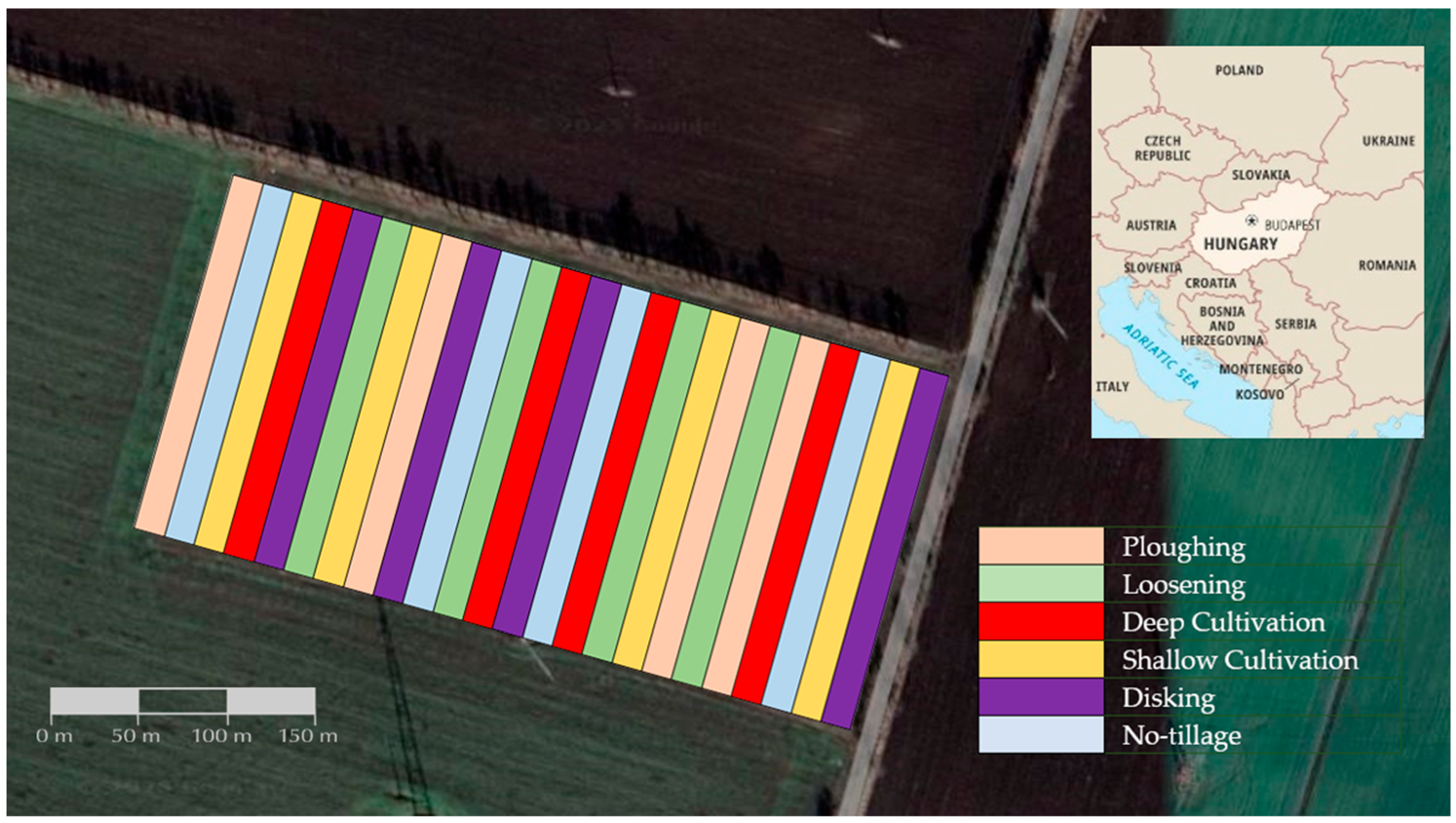
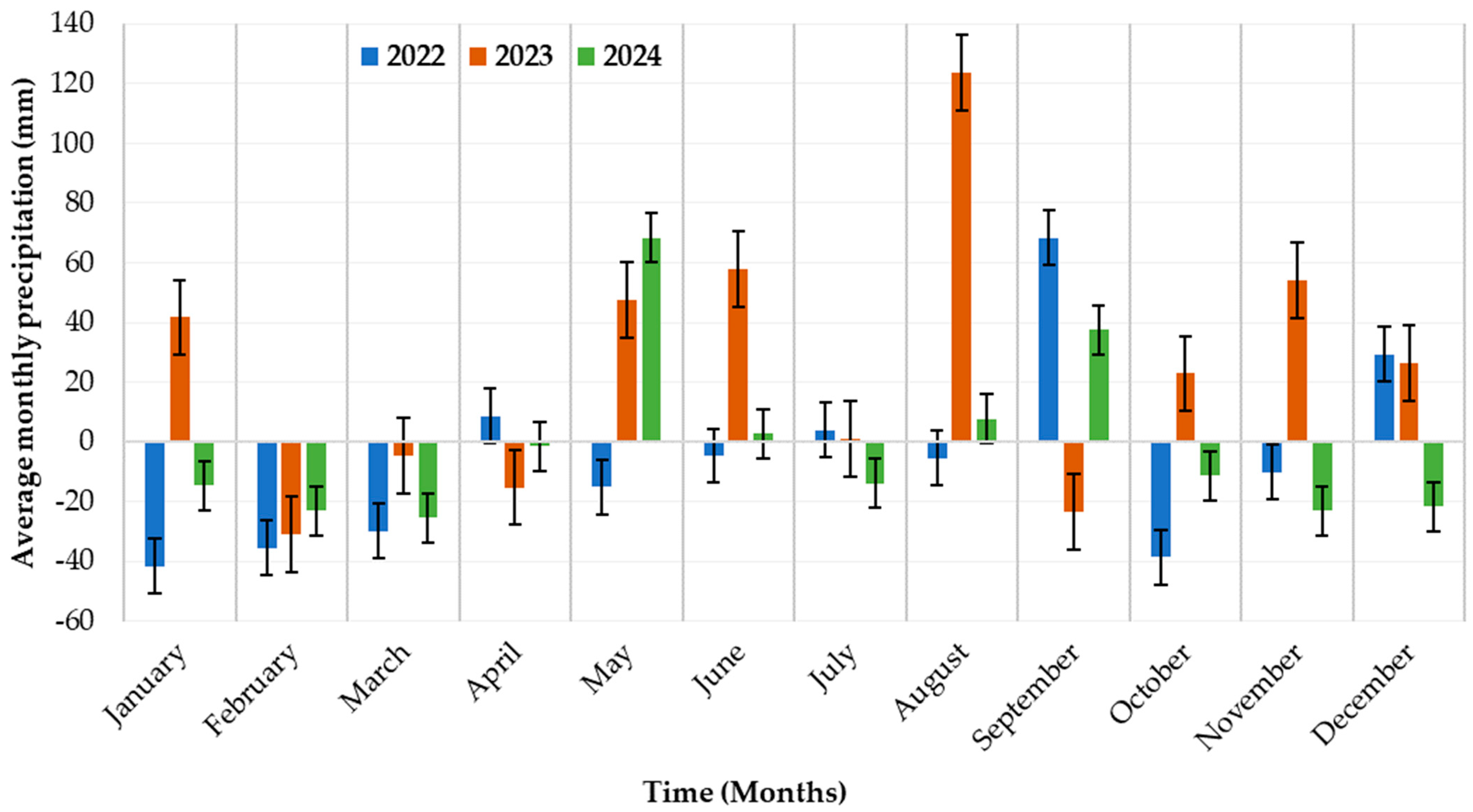
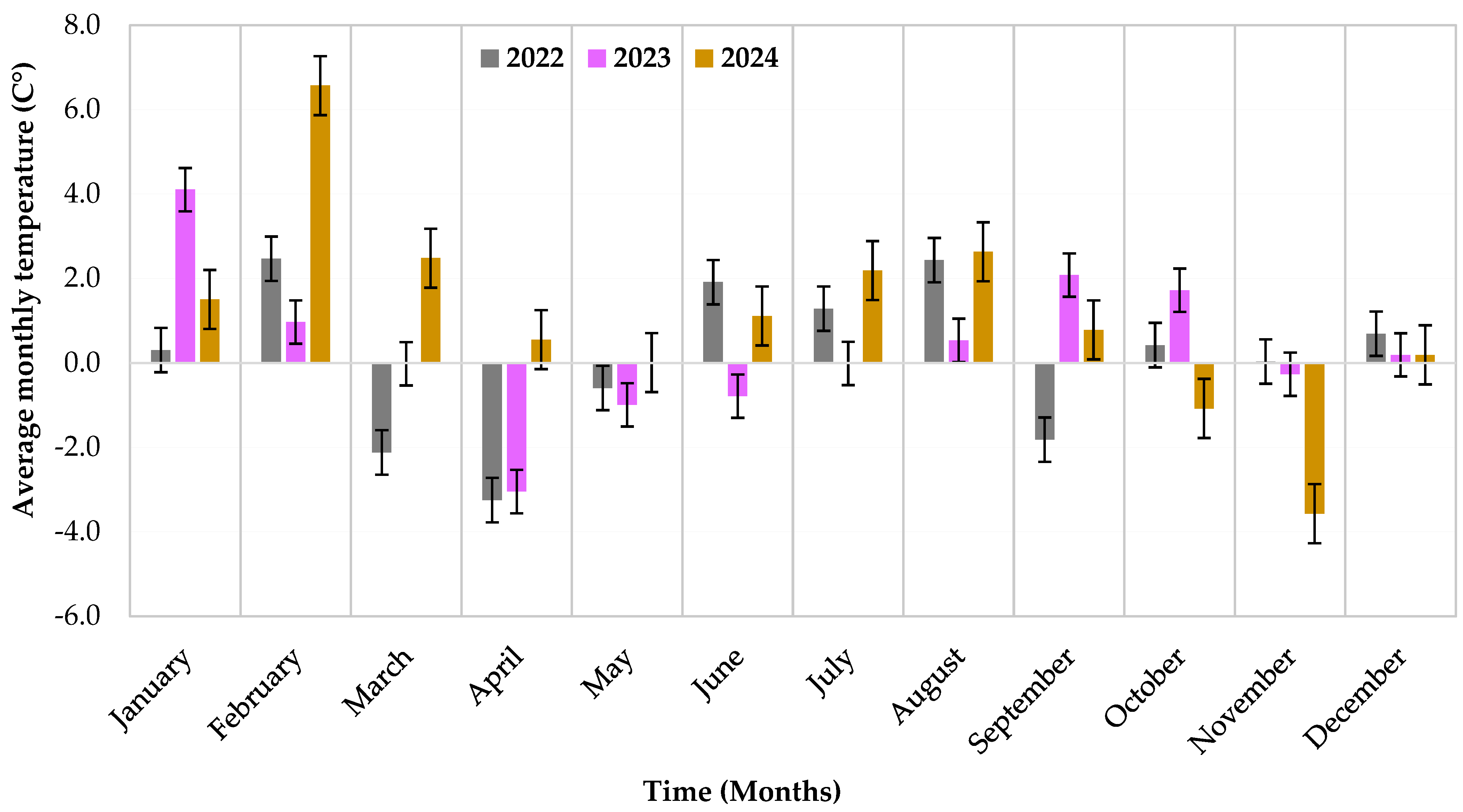

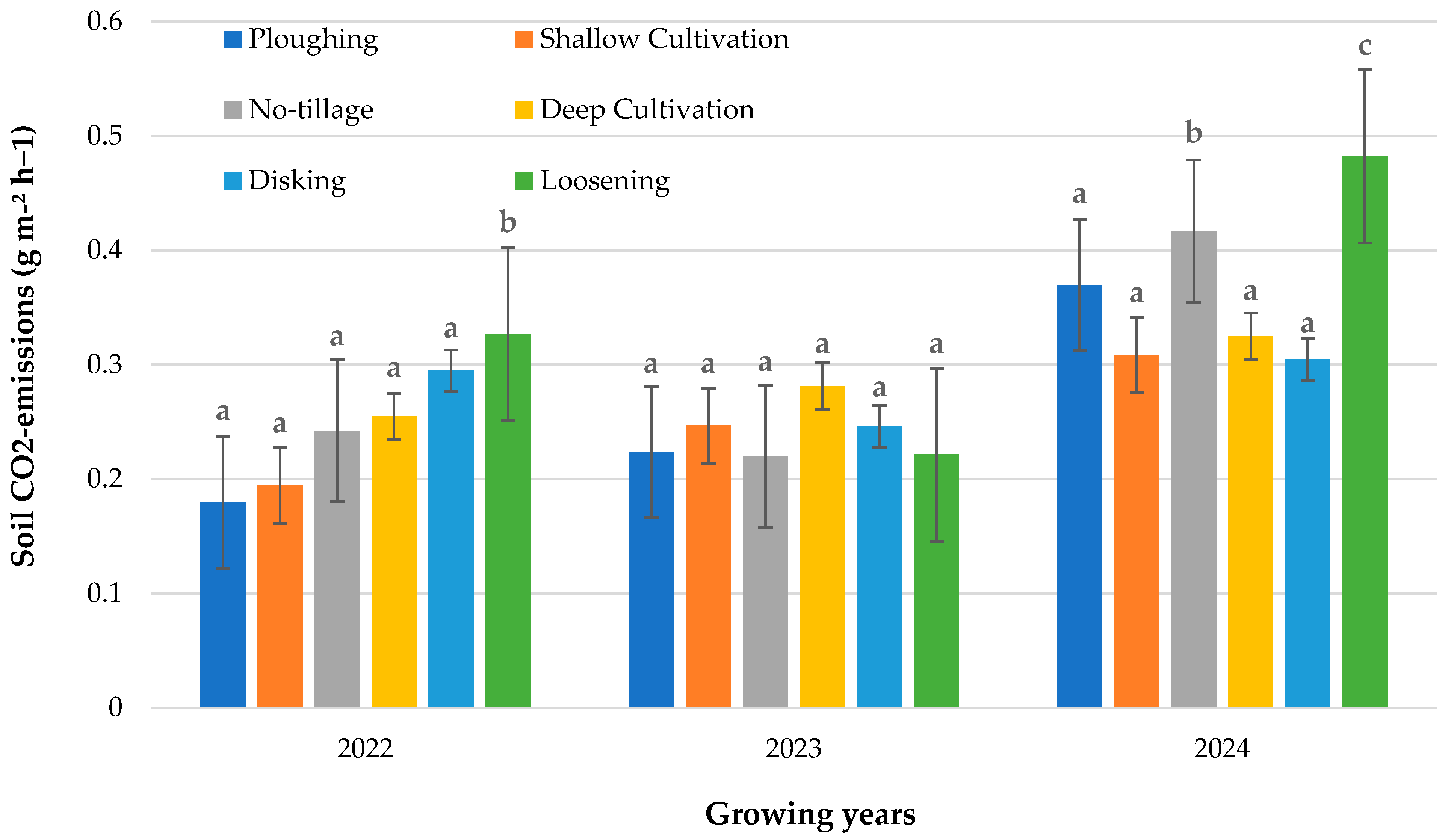
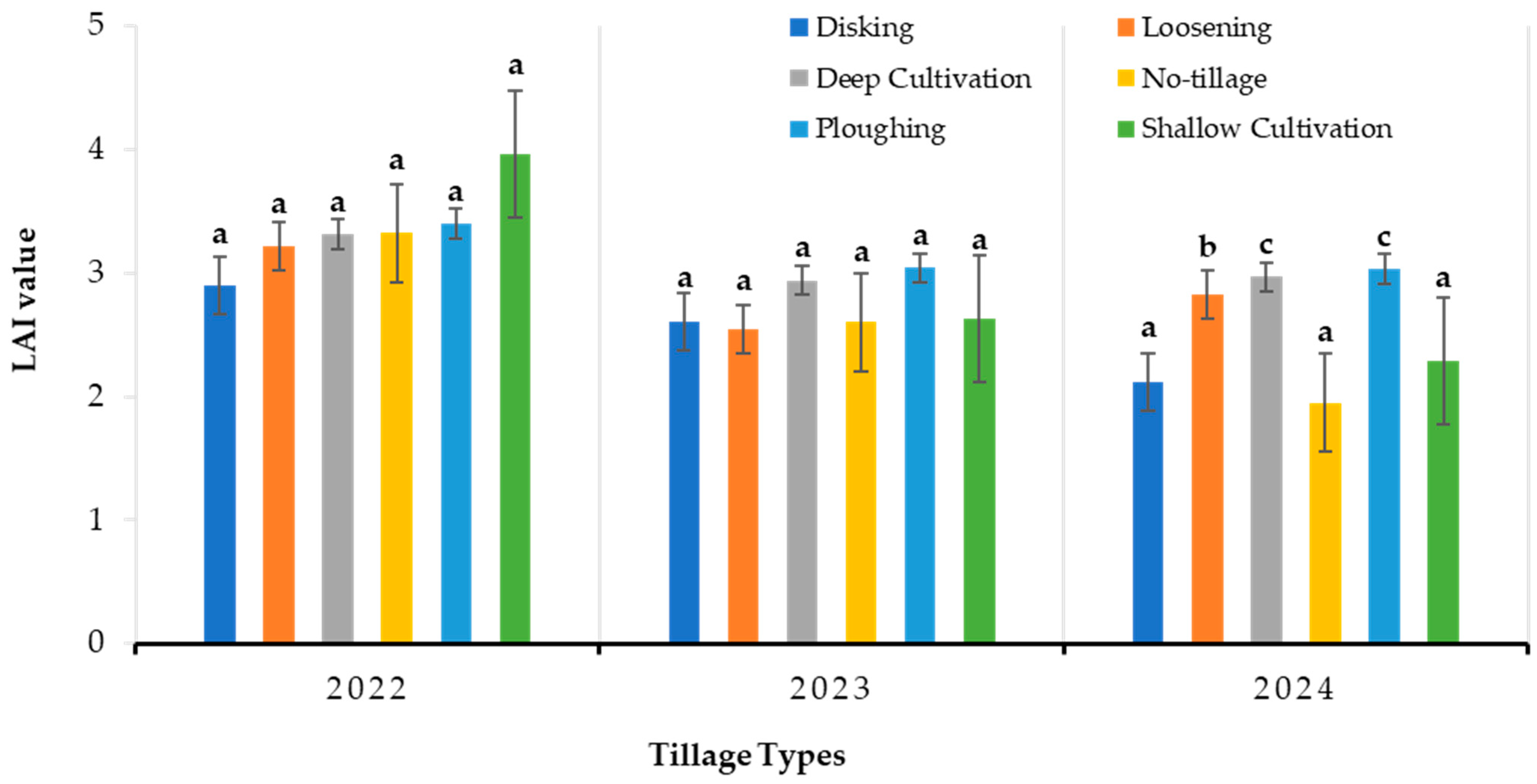
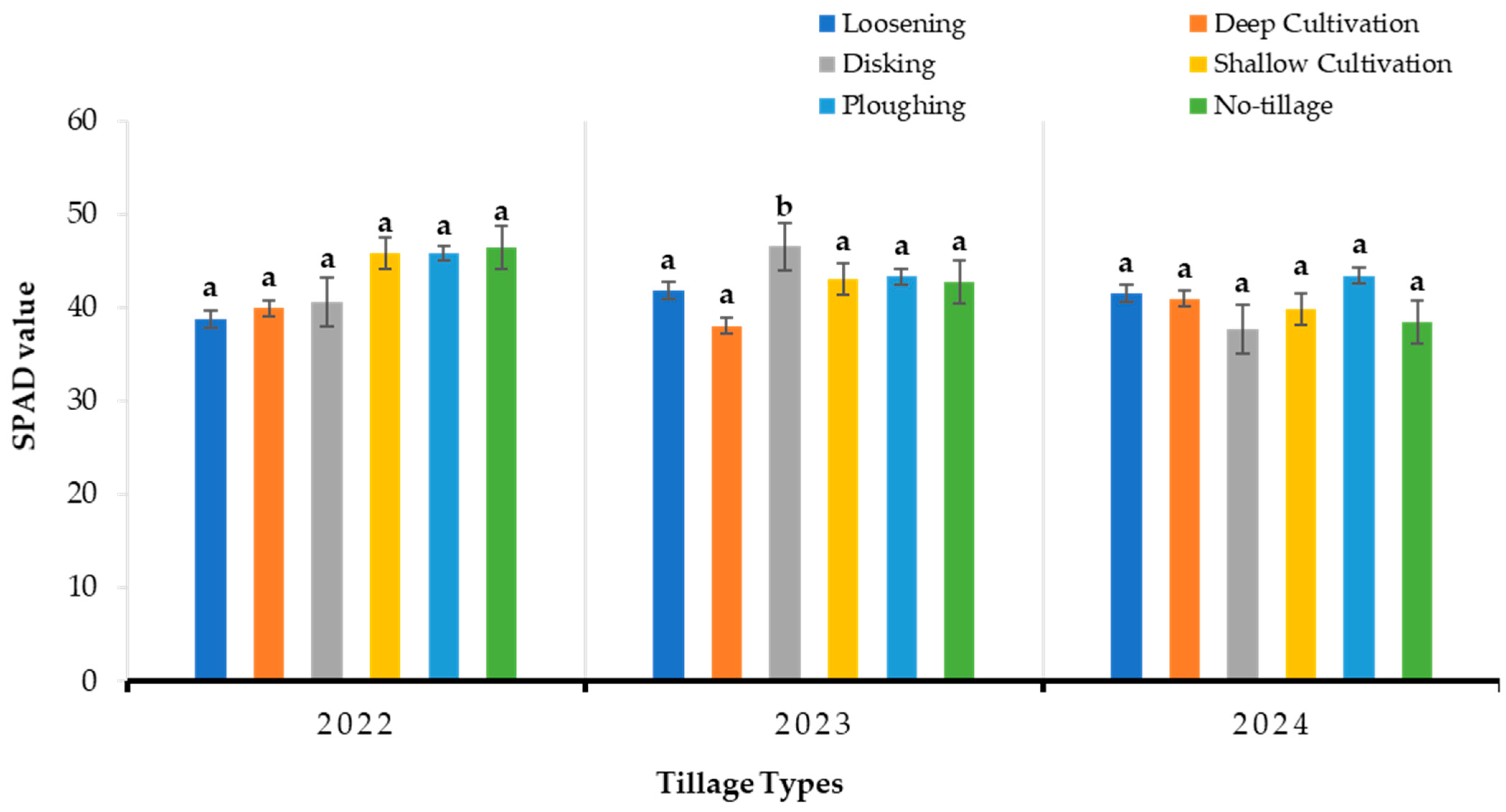
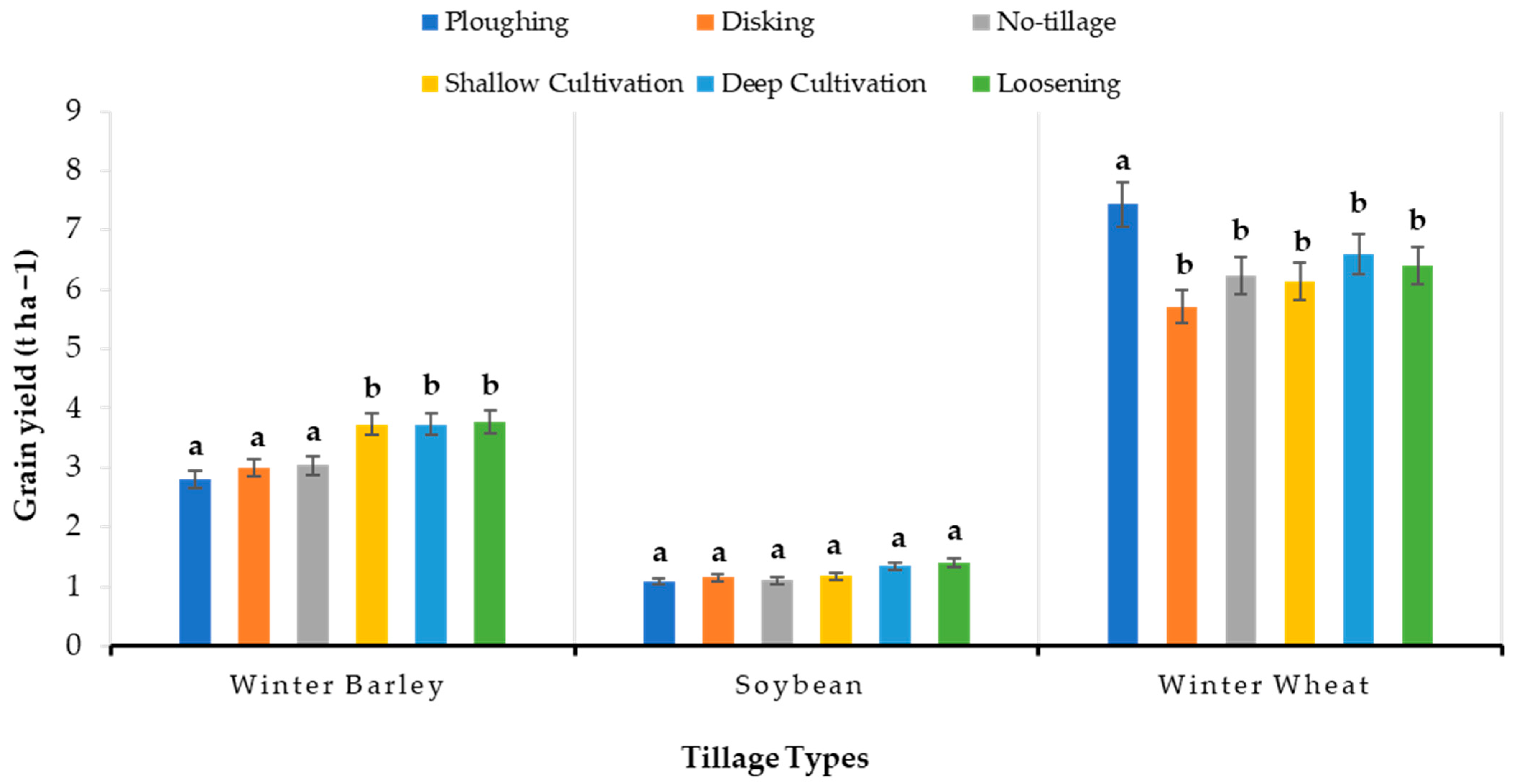

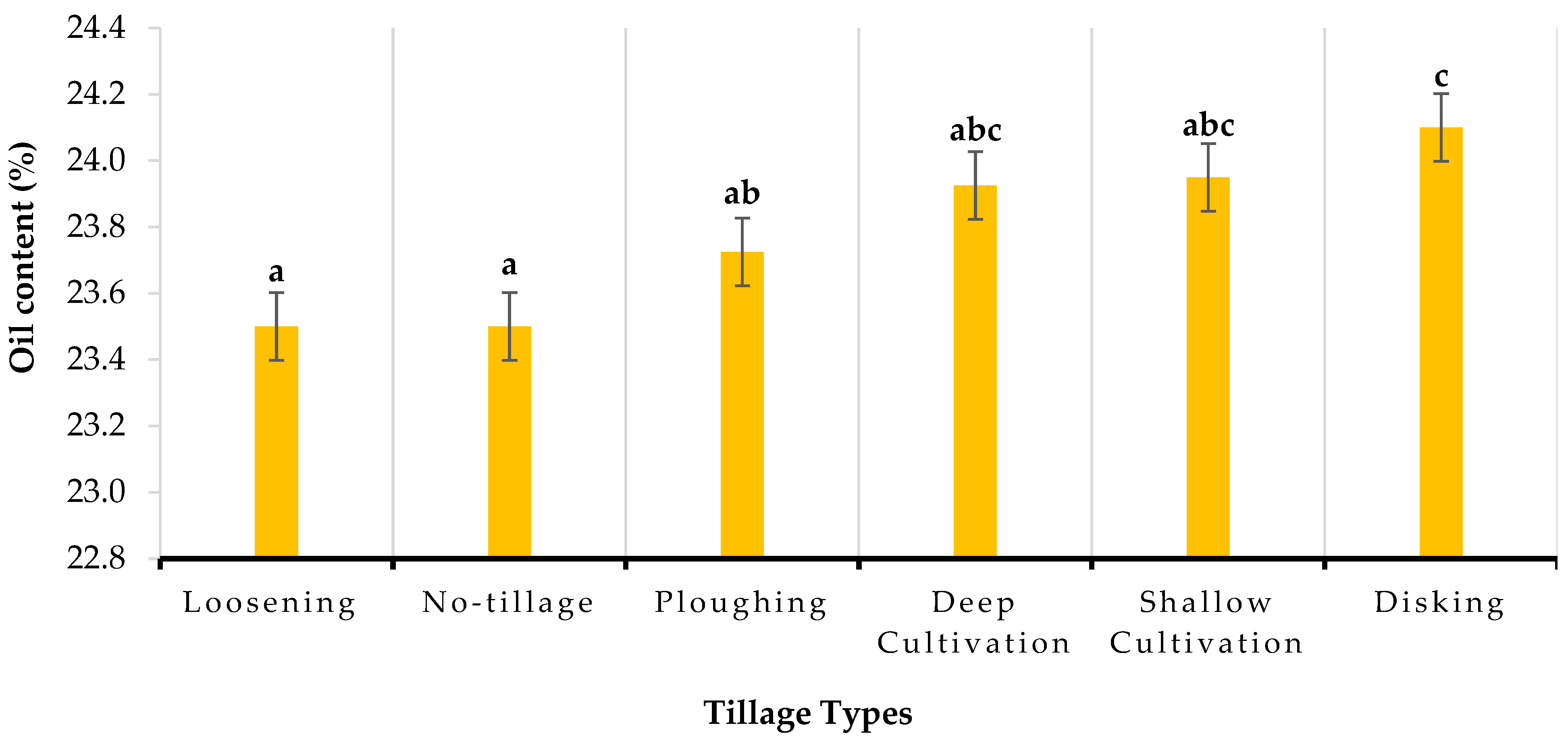
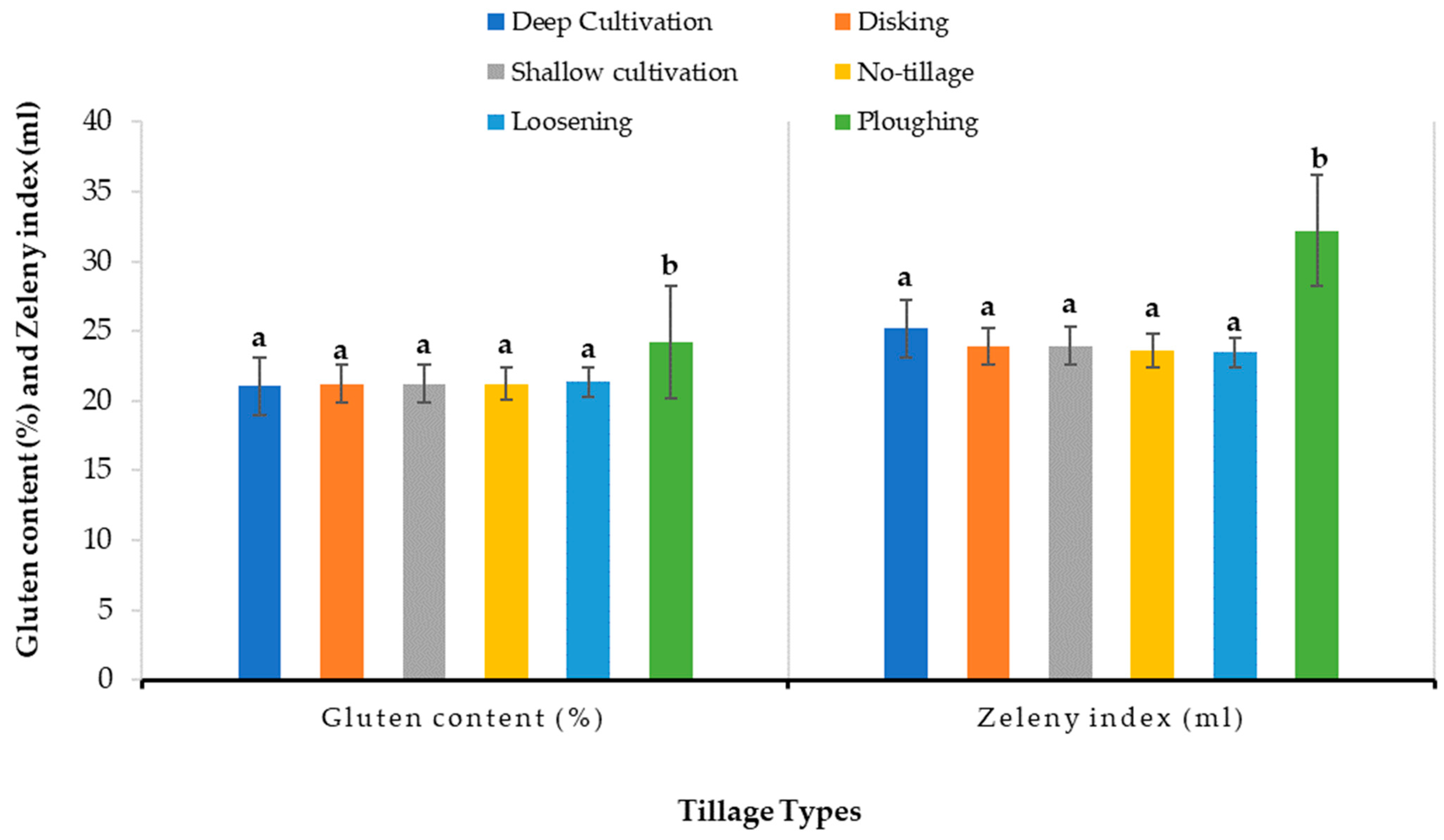
| Traits | Values | Units | |
|---|---|---|---|
| Soil Components | Clay | 350 | g kg soil−1 |
| Sand | 230 | ||
| Silt | 420 | ||
| Soil Texture | Clay loam | - | |
| Bulk Density | 1.56 | g cm−3 | |
| Organic Matter | 3.04 | g kg soil−1 | |
| Soil pH (KCl) | 4.83 | - | |
| Available Ions | N | 57.20 | mg kg−1 soil |
| P | 175.49 | ||
| K | 211.55 | ||
| Tillage Treatment | Soil Depth cm | pH (KCl) | Soil Organic Matter g kg −1 | Nitrite + Nitrate (KCl-Extractable) mg kg−1 | Phosphorus-Pentoxide (AL-Extractable) mg kg−1 | Potassium-Oxide (AL-Extractable) mg kg−1 |
|---|---|---|---|---|---|---|
| Disking | 0–10 | 4.53 | 3.76 | 8.37 | 314.00 | 312.50 |
| 10–20 | 4.72 | 3.11 | 6.53 | 215.00 | 228.75 | |
| 20–30 | 4.92 | 2.91 | 6.12 | 164.25 | 194.00 | |
| 30–40 | 5.39 | 2.76 | 14.30 | 146.38 | 197.25 | |
| Shallow Cultivation | 0–10 | 4.70 | 3.26 | 4.21 | 226.50 | 251.00 |
| 10–20 | 4.70 | 3.04 | 4.33 | 209.00 | 209.00 | |
| 20–30 | 4.89 | 2.90 | 5.18 | 171.25 | 196.50 | |
| 30–40 | 5.09 | 2.74 | 6.29 | 141.25 | 182.25 | |
| Deep Cultivation | 0–10 | 4.58 | 3.33 | 5.29 | 211.50 | 237.25 |
| 10–20 | 4.57 | 3.21 | 5.09 | 177.25 | 198.25 | |
| 20–30 | 4.67 | 3.00 | 5.97 | 147.75 | 179.75 | |
| 30–40 | 4.88 | 2.86 | 6.57 | 153.75 | 214.25 | |
| No-tillage | 0–10 | 4.40 | 3.76 | 4.66 | 303.50 | 295.50 |
| 10–20 | 4.59 | 3.31 | 7.51 | 193.25 | 219.00 | |
| 20–30 | 4.85 | 3.04 | 11.33 | 167.00 | 208.00 | |
| 30–40 | 5.21 | 2.74 | 14.05 | 124.35 | 185.50 | |
| Loosening | 0–10 | 4.81 | 3.25 | 3.75 | 183.75 | 233.00 |
| 10–20 | 4.84 | 3.10 | 4.02 | 162.25 | 204.00 | |
| 20–30 | 4.89 | 2.92 | 4.09 | 149.25 | 194.25 | |
| 30–40 | 5.07 | 2.64 | 5.12 | 101.90 | 181.75 | |
| Ploughing | 0–10 | 5.01 | 2.93 | 2.64 | 142.25 | 204.25 |
| 10–20 | 4.94 | 2.87 | 3.15 | 145.50 | 188.50 | |
| 20–30 | 5.04 | 2.85 | 3.49 | 146.50 | 189.75 | |
| 30–40 | 4.97 | 2.85 | 3.71 | 149.00 | 184.00 |
| Source of Variations | LAI | ||
|---|---|---|---|
| 2022 | 2023 | 2024 | |
| df | 5 | 5 | 5 |
| Mean Square | 0.72 | 0.78 | 10.48 |
| F-value | 2.50 | 0.40 | 8.66 |
| p-value | 0.052 | 0.847 | <0.001 |
| Source of Variations | SPAD | ||
|---|---|---|---|
| 2022 | 2023 | 2024 | |
| df | 5 | 5 | 5 |
| Mean Square | 71.92 | 135.05 | 210.18 |
| F-value | 2.10 | 2.32 | 1.25 |
| p-value | 0.093 | 0.049 | 0.288 |
| Tillage Treatments | ||||
|---|---|---|---|---|
| Dependent Variables | df | Mean Square | F-Value | p-Value |
| Winter Barley Yield (t ha−1) | 5 | 0.79 | 6.07 | 0.002 |
| Soybean Yield (t ha−1) | 5 | 0.07 | 0.85 | 0.530 |
| Winter Wheat Yield (t ha−1) | 5 | 1.34 | 4.52 | 0.008 |
| Tillage Treatments | ||||
|---|---|---|---|---|
| Dependent Variables | df | Mean Square | F-Value | p-Value |
| Protein (%) content of winter barley | 5 | 0.44 | 10.89 | <0.001 |
| Protein (%) content of soybean | 5 | 4.18 | 6.60 | <0.001 |
| Oil (%) content of soybean | 5 | 0.75 | 2.54 | 0.037 |
| Protein (%) content of winter wheat | 5 | 0.39 | 3.59 | 0.020 |
| Gluten (%) of winter wheat | 5 | 5.85 | 4.57 | 0.007 |
| Zeleny index (%) of winter wheat | 5 | 46.12 | 7.32 | <0.001 |
Disclaimer/Publisher’s Note: The statements, opinions and data contained in all publications are solely those of the individual author(s) and contributor(s) and not of MDPI and/or the editor(s). MDPI and/or the editor(s) disclaim responsibility for any injury to people or property resulting from any ideas, methods, instructions or products referred to in the content. |
© 2025 by the authors. Licensee MDPI, Basel, Switzerland. This article is an open access article distributed under the terms and conditions of the Creative Commons Attribution (CC BY) license (https://creativecommons.org/licenses/by/4.0/).
Share and Cite
Bozóki, B.; Bogale, A.A.; Khaeim, H.; Kende, Z.; Simon, B.; Kovács, G.P.; Gyuricza, C. Impact of Soil Tillage Systems on CO2 Emissions, Soil Chemical Parameters, and Plant Growth Physiological Parameters (LAI, SPAD) in a Long-Term Tillage Experiment in Hungary. Agriculture 2025, 15, 1810. https://doi.org/10.3390/agriculture15171810
Bozóki B, Bogale AA, Khaeim H, Kende Z, Simon B, Kovács GP, Gyuricza C. Impact of Soil Tillage Systems on CO2 Emissions, Soil Chemical Parameters, and Plant Growth Physiological Parameters (LAI, SPAD) in a Long-Term Tillage Experiment in Hungary. Agriculture. 2025; 15(17):1810. https://doi.org/10.3390/agriculture15171810
Chicago/Turabian StyleBozóki, Boglárka, Amare Assefa Bogale, Hussein Khaeim, Zoltán Kende, Barbara Simon, Gergő Péter Kovács, and Csaba Gyuricza. 2025. "Impact of Soil Tillage Systems on CO2 Emissions, Soil Chemical Parameters, and Plant Growth Physiological Parameters (LAI, SPAD) in a Long-Term Tillage Experiment in Hungary" Agriculture 15, no. 17: 1810. https://doi.org/10.3390/agriculture15171810
APA StyleBozóki, B., Bogale, A. A., Khaeim, H., Kende, Z., Simon, B., Kovács, G. P., & Gyuricza, C. (2025). Impact of Soil Tillage Systems on CO2 Emissions, Soil Chemical Parameters, and Plant Growth Physiological Parameters (LAI, SPAD) in a Long-Term Tillage Experiment in Hungary. Agriculture, 15(17), 1810. https://doi.org/10.3390/agriculture15171810








